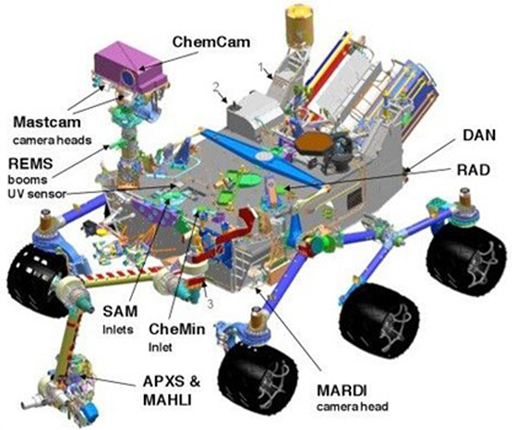1.1.2 Biosignatures
Carbon is fundamental to every living organism because it can form covalent bonds with atoms of many other elements.
A covalent bond is a bond in which pairs of electrons are shared between atoms (one electron is shared from each atom).
This ability to chemically bond with other elements means it offers the opportunity for chemical variability to emerge, resulting in a wide variety of organic molecules. You might be familiar with the term ‘organic’ in different contexts, for example, organic foods are those produced without synthetic fertilisers, and ‘organic’ is often used to describe anything associated with biology. However, organic molecules and the science of organic chemistry are concerned only with the chemistry of compounds that contain carbon.
Living systems on Earth are based on organic molecules (e.g., lipids, carbohydrates, proteins and nucleic acids). Most of these molecules are large (macromolecules), made of smaller molecular building blocks, such as amino acids. However, life also generates organic molecules; methane (CH4) is an example of a carbon molecule generated through metabolic processes. Any of these molecules might be indicative of the presence, or past presence, of life. In this respect, we call these molecules ‘biosignatures’ – biological signatures. However, there are many other potential biosignatures, not all associated with organic molecules. These are summarised on Table 2.
| Table 2 Types of biosignatures used in the search for life beyond Earth. | ||
|---|---|---|
| Type of Biosignature | Description | Examples |
| Chemical biosignatures | ||
| Organic molecules | Molecules containing carbon that are found in biological organisms that may be left by the breakdown of cells. Some may survive over long periods of time, preserved in rocks and minerals. | Lipids, carbohydrates, nucleic acids, proteins or fragments of those macromolecules |
| Atmospheric gases | Gases produced by life through its metabolic processes. These need to be present in sufficient quantities for detection, be concentrated in specific areas, accompanied by other gases, or at specific times, for it to suggest the present of life. | Oxygen (O2), methane (CH4), nitrous oxide (N2O) |
| Isotope ratios | Organisms tend to prefer utilising lighter stable isotopes during metabolism, leaving light isotopes behind as evidence. If more lighter isotopes of certain elements are found this could suggest the presence of life. | 12C is preferred over 13C |
| Chirality | Some organic molecules express a preferred orientation to their structure if they are from a biological organism, compared to when they are formed by non-biological processes. | L-alanine (biological) compared to D-alanine (non-biological) |
| Chemical Disequilibrium | The co-existence of substances that should otherwise be incompatible because they would react with one another. | Co-existence of CH4, and O2, in Earth’s atmosphere |
| Physical biosignatures | ||
| Microfossils | Physical traces of an organism in the rock record. Often produced when the organic parts of an organism are replaced by inorganic minerals. | Bacterial microfossils in ancient terrestrial rocks |
| Textural fabrics | Some organisms can influence the structure of sediments around them by trapping sediments. Can be difficult to distinguish from non-biological features. | Stromatolites, filamentous structures |
| Biogenic minerals | Minerals that can be formed by biological processes | Carbonates, phosphates |
You will notice that only some of the biosignatures on Table 2 are directly associated with life while others indirectly indicate that life was once present. For example, some organisms may promote the formation of certain minerals (biogenic minerals) – this would be indirect evidence of past life.
-
From Table 2, what other biosignatures can be considered indirect evidence of life?
-
Atmospheric gases, isotope ratios, chemical disequilibrium and chirality are all indirect indicators that life is or has been present.
Finding biosignatures preserved in the geological record or atmosphere of another planetary body would be a significant scientific discovery and so it is critical to determine that it is indeed formed by life, i.e. that it is biotic, and was not formed by other natural processes that might operate in the environment, i.e., is abiotic.
It is therefore critically important that we do not inadvertently carry organisms or substances that might give us a false positive result (i.e. that suggest life is present, but it is in fact from Earth). We must be sure that missions are able to gather robust and unequivocal evidence, and that the scientific integrity of the mission is maintained. This contamination of the environment of another planetary body, in the context of planetary protection, is called forward contamination.
Further, it is also important to ensure that, in our quest to find evidence of life, we do not disturb or destroy such evidence through our investigations. This is challenging because to search for biosignatures or determine if an environment is habitable requires complex physical and chemical analyses, including of the geological record. This is done using scientific instruments hosted on rovers or landers that interact with a planetary surface, scooping rocks, drilling into the surface or even destroying small areas using lasers.
These robotic missions are superb feats of engineering, often miniaturising otherwise large laboratory instruments so they can be sent to another planet (e.g., Figure 3) but they are also made of materials that could be harmful to other environments without proper precaution. This is where planetary protection plays a critical role.

A further challenge to facing missions is that many specifically target regions for exploration precisely because they are likely to host biosignatures, especially environments that are thought to be, or have been, habitable.
